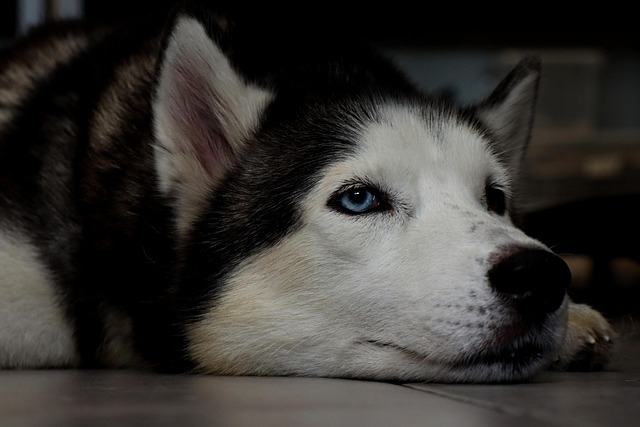
What is glaucoma in a dog?
You might notice your dog squinting more at mealtime or avoiding bright sunlight—these small changes could be early signs of a serious eye condition.
Huskies are known for their striking eyes—those icy blues, warm browns, or even one of each that seem to hold a thousand stories. But beneath that beauty lies a risk: these dogs are prone to certain genetic eye diseases that every owner should know about. It’s not something to panic over, but being informed can make all the difference in keeping your Husky’s eyes healthy for years to come.
One of the most common genetic eye issues in Huskies is progressive retinal atrophy, often called PRA. This condition slowly breaks down the retina, the part of the eye that helps them see light and shapes. At first, you might notice your Husky struggling to see in dim light—like hesitating when moving from a bright room to a darker one. Over time, it can lead to full blindness. The tricky part? It’s inherited, meaning puppies can be born with the gene even if their parents don’t show symptoms. Many breeders now test for PRA before breeding, which is a good sign you’re dealing with someone responsible—always ask to see those test results when picking out a Husky pup.
Then there’s corneal dystrophy, a condition that affects the clear outer layer of the eye, the cornea. In Huskies, this often shows up as cloudy spots that can grow over time. It might not cause pain at first, but if the clouding gets bad enough, it can blur their vision. Vets can keep an eye on it during regular check-ups, and in some cases, treatments can slow it down. It’s another reason why choosing a breeder who screens for genetic issues matters—corneal dystrophy runs in lines, so avoiding affected bloodlines lowers the risk.
 Cataracts are also more common in Huskies than in some other breeds, and while they can come from old age or injury, many are genetic. These form when the lens of the eye gets cloudy, making it hard for light to pass through. You might notice a white or grayish spot in their eye, and if left untreated, they can lead to blindness. The good news is, surgery can often remove them, restoring sight in many cases. Pet insurance can be a big help here—many plans cover genetic conditions, which is worth looking into since these procedures can add up.
Cataracts are also more common in Huskies than in some other breeds, and while they can come from old age or injury, many are genetic. These form when the lens of the eye gets cloudy, making it hard for light to pass through. You might notice a white or grayish spot in their eye, and if left untreated, they can lead to blindness. The good news is, surgery can often remove them, restoring sight in many cases. Pet insurance can be a big help here—many plans cover genetic conditions, which is worth looking into since these procedures can add up.
Glaucoma is another concern, though it’s not always genetic. When fluid builds up in the eye, it creates pressure that damages the optic nerve. Huskies with genetic predispositions might develop it earlier, and it’s painful—you might see them squinting, avoiding light, or their eye might look swollen. Catching it early is key, as meds or surgery can reduce pressure and save their vision. Regular eye exams, even when your Husky seems fine, can catch these issues before they get worse.
It’s not all doom and gloom, though. Knowing about these genetic eye diseases in Huskies lets you be proactive. Reputable breeders follow guidelines to test breeding dogs, which cuts down on passing these genes along. If you’re adopting a rescue, a vet check-up within the first week can spot early signs, giving you a head start on care. Many regions have laws requiring breeders to disclose known genetic issues, so don’t hesitate to ask for records—being informed is part of being a responsible owner.
Watching your Husky run through snow or chase a ball, their eyes shining, is one of the joys of having them. By staying on top of their eye health—knowing the signs, choosing a good breeder, and keeping up with vet visits—you can help protect that sparkle. These dogs are tough, and with a little care, they can live happy, active lives even with some eye challenges. After all, their spirit doesn’t depend on perfect vision—it’s all in that playful, adventurous heart.

You might notice your dog squinting more at mealtime or avoiding bright sunlight—these small changes could be early signs of a serious eye condition.

Let’s set the scene: It’s a sweltering Phoenix afternoon—105°F outside—and you rushed your 2-year-old Lab mix, Cooper, on a quick walk to “get it over with.”

Let’s get real: You’re in your Miami apartment, watching your 3-year-old Corgi, Loki, struggle to climb the stairs to your second-floor unit.

Many dog owners brush off occasional scratching as just “dog behavior,” but persistent itching often signals something more—like a food allergy.

You might first notice your dog scratching more than usual—chewing at their paws until the fur looks thin, or rubbing their face against the couch nonstop.

Let’s be real: You’re standing in your Chicago apartment, watching your 3-year-old Beagle, Max, huff and puff just to climb onto the couch.